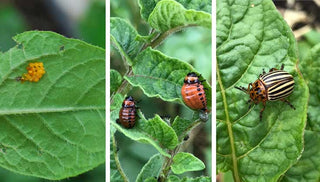Diagnosing plant problems is a little like playing Clue — but instead of uncovering a murderer you're trying to figure out who or what is bugging your plants. Sherlock Holmes was famous for his powers of observation and reasoning, and if you want to identify plant problems you'll need to hone these skills.
1. Observe
Try to visit your garden daily and get to know what your plants look like when they're healthy — so you'll notice any problems right away. When you do see something out of the ordinary, stop for a closer look. What caught your eye? Off-color foliage? Holes in the leaves?
If you want to avoid using poisons in your garden, the key to success is taking time to look closely. It's the single most important action you can take. Here are a couple questions to get you started:
2. Name That Plant
What kind of plant is it? Some types of plants are particularly susceptible to certain pests or disease problems. If you're growing edibles, look at the entry in our Vegetetable Encyclopedia for common pests.
 Sometimes you'll see signs, such as shiny slug trails, without seeing the actual culprit.
Sometimes you'll see signs, such as shiny slug trails, without seeing the actual culprit.3. Do the Leaves Appear Eaten?
The culprit might be an insect, slug or animal pest. Large holes in the middle of the leaf can indicate beetles, caterpillars and slugs. Shredded foliage or plants eaten right down to the ground might be the work of an animal, such as a deer or woodchuck. Browse our Pest and Disease Directory for help.
 Here you can see the damage and the culprit. Rose slugs (enlarged in inset) aren't true slugs but rather the larvae of flying insects called sawflies. The larvae scrape the flesh off the foliage, leaving windowpane-like areas.
Here you can see the damage and the culprit. Rose slugs (enlarged in inset) aren't true slugs but rather the larvae of flying insects called sawflies. The larvae scrape the flesh off the foliage, leaving windowpane-like areas.4. Are the Leaves Discolored?
If so, how? Silvery, bronzed or stippled foliage may indicate the presence of plant juice-sucking insects such as aphids and spider mites. Pale or mottled leaves can indicate an environmental or nutrition problem.
5. Are there Spots on the Leaves?
They may be caused by a disease. But they can also be the result of insect feeding or environmental factors. Some plants are notorious for their susceptibility to certain diseases.
6. Look for the Culprit
Do you see insects, eggs or droppings? Some insects are difficult to see but they leave telltale signs. For example, some cabbageworms are so well camouflaged you may not see them, but you'll see their black droppings. Eggs may be clustered on the undersides of leaves or on new growth, so be sure to look there, too.
Keep in mind that the insects you see may not be causing the symptoms. Ants, for example, are sometimes found on damaged plants and are assumed to be the culprit. But they generally don't harm plants — they're after the honeydew (a sugary secretion) left by the real pests, usually aphids. Other insects, such as lacewing or ladybug larvae are beneficial insects that may already be busy solving the problem by hunting down the pests.
7. Look for Other Signs and Symptoms
Examine plants for anything out of place. Some pests are so tiny you're unlikely to see them, but on close inspection you'll see signs of their presence. For example, spider mites are smaller than a pinhead but reveal their presence with the silky webbing they produce. Though slugs feed at night and usually hide out during the day, the shiny slime trails they leave behind are telltale "footprints."

It's easy to see this cabbageworm on a pale green cabbage leaf, but harder to spot it on a stem of broccoli. You can't miss the green-black frass (droppings), however. Photo: Whitney Cranshaw, Colorado State University, Bugwood.org, author of Garden Insects of North America
Is It Necessary to Take Action?
Consider the options. Don't immediately switch into "spray mode" if you recognize a pest or its damage. If you see holes in the foliage but no insects, it could be that they've already come and gone. If there are only a few pests, you may want to just track the situation for a day or two and see what happens. Giving the plant a fortifying drink of water, spiked with some liquid organic fertilizer may be all that's required.
If it's the end of the growing season, control may not be warranted. If, on the other hand, it's early in the season and the plant is at risk, you may need to act quickly. Diseases pose different challenges. Most products that control diseases are preventative — they won't cure a disease but can keep it from spreading. You may also be able to keep a disease problem in check by removing and destroying affected leaves or parts of the plant.
Remember that many pests and diseases can be kept in check with good gardening practices. Pesticides and fungicides — even organic ones — should always be a last resort.





